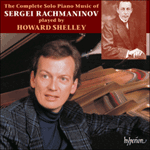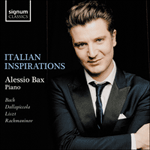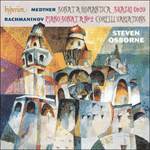
Welcome to Hyperion Records, a British classical label devoted to presenting high-quality recordings of music of all styles and from all periods from the twelfth century to the twenty-first.
Hyperion offers both CDs, and downloads in a number of formats. The site is also available in several languages.
Please use the dropdown buttons to set your preferred options, or use the checkbox to accept the defaults.

Not entirely convinced of the success of the 'Corelli Variations', Rachmaninov generally omitted some of the twenty variations in performance. In three instances (Nos 11, 12 and 19) he even allowed that option in the score. He explained himself drily in a letter to Medtner of 21 December 1931: ‘I was guided by the coughing of the audience. Whenever the coughing increased, I would skip the next variation. Whenever there was no coughing, I would play them in proper order.’ In fact the design works perfectly well without such surgery, the variations grouping themselves into a quasi-four-movement sonata, in which the ‘slow movement’ begins in the major mode after a cadenza-like ‘Intermezzo’.
from notes by David Fanning © 2014
Pas totalement convaincu du succès de ses vingt Variations sur un thème de Corelli, Rachmaninov en omettait généralement certaines quand il les jouait. Pour trois d’entre elles (les nos 11, 12 et 19), il permit même cette option sur la partition. Il s’en expliqua sèchement dans une lettre adressée à Medtner le 21 décembre 1931: «J’ai été guidé par la toux du public. Dès qu’elle forcissait, je sautais à la variation suivante. Dès qu’il n’y en avait pas, je les jouais dans le bon ordre.» En fait, tout fonctionne parfaitement bien sans de telles manœuvres: les variations forment une quasi-sonate en quatre mouvements, le «mouvement lent» démarrant en majeur après un «Intermezzo» façon cadence.
extrait des notes rédigées par David Fanning © 2014
Français: Hypérion
Rachmaninow war von dem Erfolg der „Corelli-Variationen“ nicht völlig überzeugt und ließ in Konzerten von den insgesamt zwanzig Variationen oft einige aus. Bei drei Stücken (Nr. 11, 12 und 19) hielt er diese Option sogar im Notentext fest. In einem Brief vom 21. Dezember 1931 an Medtner erklärte er trocken: „Ich ließ mich von dem Husten im Publikum leiten. Immer wenn das Husten mehr wurde, ließ ich die nächste Variation aus. Wenn nicht gehustet wurde, spielte ich sie in der rechten Reihenfolge.“ Tatsächlich lässt sich das Werk auch ohne derartige Operationen sehr gut ausführen—die Variationen fallen sozusagen in eine viersätzige Sonatenform, wobei nach einem kadenzartigen „Intermezzo“ der „langsame Satz“ in Dur beginnt.
aus dem Begleittext von David Fanning © 2014
Deutsch: Viola Scheffel
 Rachmaninov: The Complete Solo Piano Music Rachmaninov: The Complete Solo Piano Music‘A fine achievement from Howard Shelley and Hyperion alike. These superbly recorded, idiomatic readings demonstrate Shelley's virtuoso pianism and aff ... ‘A significant testimony to Howard Shelley's artistry. Pianistically impeccable, he understands what Rachmaninov was about’ (Gramophone)» More |
 Italian inspirations Italian inspirationsAlessio Bax performs a personal selection of piano works inspired by Italian composers through the centuries, from Bach's re-imagining of a Baroque oboe concerto, through works by Rachmaninov and Dallapiccola, and ending with two of Liszt's most c ...» More |
 Medtner & Rachmaninov: Piano Sonatas Medtner & Rachmaninov: Piano SonatasSteven Osborne has become increasingly admired for his performances and recordings of Russian Romantic piano music. Here he presents an impressive selection from two masters who lived and worked contemporaneously. Medtner’s ‘Sonata Romantica’ is i ...» More |

